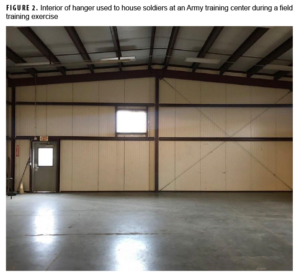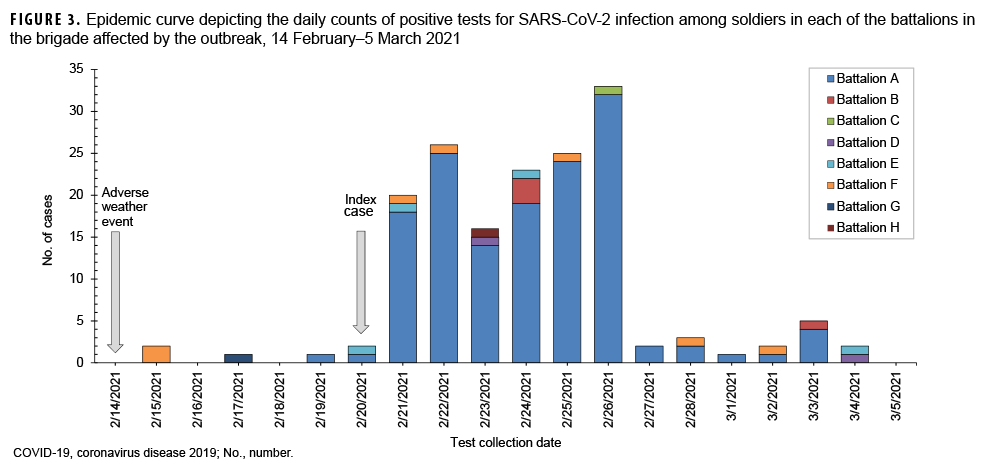YAKIMA, WA — Extreme weather during a field training exercise forced more than 100 Joint Base Lewis-McChord soldiers to shelter closely together last year and led to an extensive outbreak of COVID-19.
“This report illustrates important lessons learned whose implementation in the future will enable better protection of servicemembers from COVID-19 and similar health risks associated with training,” according to the Madigan Army Medical Center-led authors.
Details were published recently in Medical Surveillance Monthly Report, about a year after the incident occurred.
In February 2021, “extreme weather during the exercise disrupted planned COVID-19 mitigation measures and caused 110 soldiers to be sheltered in a small aircraft hangar for several nights,” according to the report, which added that the probable index case had reported to sick call with symptoms compatible with COVID-19 but was not properly diagnosed. That soldier was returned to duty and was allowed to remain in the enclosed hangar for three additional days.
Ultimately, 143 individuals with epidemiologic ties to the field training exercise tested positive for SARS-CoV-2 during the outbreak. Nine samples sent for sequencing were determined to be the SARS-CoV-2 Beta variant.
“COVID-19 is a threat to military exercises because of the virus’s ability to cause illness in a large number of soldiers,” the authors warned. “Results of this investigation demonstrate the potential impact of a COVID-19 outbreak in land-based military congregate living settings, especially those with shared sleeping spaces.”
They pointed out that, in addition to mandated immunization, it is important to assure pre-deployment screening, basic hygiene measures such as sufficient sleeping space and ready access to appropriate clinical assessment and diagnostic testing in order to mitigate the risk of a potential COVID-19 outbreak in military training settings.
The report described how, during Feb. 4-19, 2021, an infantry battalion, (battalion A) of a brigade (herein Brigade X) from JBLM conducted a tactical field training exercise at an Army training center in Yakima, WA. Brigade X is an infantry unit comprised of 8 battalions, which typically include about 1,000 soldiers distributed among four to six companies.
“Neither symptom-based nor laboratory-based COVID-19 screening of the soldier participants was performed prior to deployment,” according to the article. “Soldiers of Battalion A conducted platoon- and company-level training in groups of approximately 40 or 275 personnel at a time, rotating through different training iterations to maximize physical distance between soldiers as much as practically possible. Handwashing stations were placed near all tactical operations centers, latrines, and designated dining areas. Use of face covering was mandated by policy and enforced by leadership. Despite COVID-19 mitigation measures that were integrated in the planning of the field training exercise, extreme environmental conditions and logistical difficulties made these measures difficult to execute and maintain.”
On Feb. 12, extreme weather with temperatures reaching 13 °F (-10 °C) with roughly 2 inches (5 cm) of snow and wind gusts up to 14 mph occurred. To help protect them from the dangerous weather, 110 soldiers (an infantry company of 103 soldiers and a group of seven medics from a separate supporting company) were moved into an aircraft hangar, which remained their sleeping arrangement for the remainder of the field training exercise.
The aircraft hangar, which was approximately 75 ft (23 m) x 85 ft (26 m) or 6,375 square feet (592 square meters) in size, had no mechanical heating or ventilation system, and the windows were kept closed to keep the heat in.
“Furthermore, because of limited space, many soldiers slept on the ground in their military issued 5-component modular sleep systems with roughly 2 feet of space between soldiers,” the authors explained. “Based on minimum acceptable sleeping space allowance of 72 square feet of floor space per person, the aircraft hangar had a maximum capacity of 88 personnel (6,375/72=88.5). By housing 110 soldiers in this space, the unit’s use of the hangar exceeded recommended public health capacity by 22 soldiers.”
The unit returned earlier than planned to base, using buses within which recommended physical distancing could not be achieved. Shortly thereafter, the soldiers began reporting symptoms of COVID-19.
Initial Symptoms
The affected soldier who was the index case had reported initial symptoms of fever (101.6 °F, 38.7 °C) and chills that started on Feb. 16, 2021. This soldier was evaluated by medics in the field on the day of his symptom onset, but was not suspected as having COVID-19. Instead, he was rehydrated and returned to duty where he resumed normal training activities for the next three days among other soldiers, including sleeping in the enclosed hangar.
With contact tracing, the total number of positive cases from this company reached 87; an additional 42 positive cases were identified in the support company to which the medical detachment belonged. An additional 19 cases were identified as part of the outbreak that were not part of the battalion but were linked epidemiologically, according to the report.
In an editorial, the authors stated, “This report describes a COVID-19 outbreak tied to a single military training event that affected almost a quarter (23.8%) of soldiers in an infantry battalion. The current findings demonstrate that highly contagious variants could be of particular concern in military congregate living settings, especially those with shared sleeping spaces.”
They added that disease severity during the outbreak was generally mild in an otherwise healthy population but cautioned that “the results underscore the negative impact (i.e., 24% of a battalion isolated or quarantined) that a COVID-19 outbreak, especially of a highly contagious variant, can have on readiness.”
They added that the experience of the two vaccinated medics supports the effectiveness of vaccinations in combating COVID-19 transmission.
“Military leaders are tasked with optimizing and maintaining combat readiness of their soldiers and the unit,” according to the authors. “The COVID-19 pandemic presents a unique challenge to leaders in balancing combat readiness against mitigation of SARS-CoV-2 transmission. Although this battalion’s leadership took additional steps to ensure COVID-19 mitigation measures were incorporated into every aspect of the field training exercise, this outbreak was not prevented.”
The report identifies three key issues contributing to the outbreak:
- The unit did not include pre-deployment COVID-19 screening as part of operational plans, even if that likely would not have picked up the index case who developed symptoms the 13th day of training.
- The unit’s contingency plan for extreme weather conditions did not incorporate adequate COVID-19 mitigation measures in indoor settings. Not only did overcrowded indoor sleeping arrangements, coupled with poor ventilation, create ideal conditions for widespread transmission of a highly contagious variant of COVID-19, but crowded buses might have exacerbated the situation.
- Despite the index case presenting to the platoon aid station with report of chills and a fever on Feb. 16, 2021, four days before laboratory-confirmed diagnosis of SARS-CoV-2 infection, the soldier was not evaluated for COVID-19 or placed in isolation. Instead, the soldier was returned to duty.
“This misstep could have been averted through the use of an effective screening protocol that triggered isolation and testing for anyone presenting with symptoms consistent with COVID-19. Early removal and testing of the index case might have significantly reduced the number of positive cases in this outbreak,” the authors pointed out.
The authors concluded, “The findings of this study can inform mitigation efforts in military units in a deployed or field training environment and are particularly applicable in the setting of the Delta variant as the predominant cause of COVID-19. Like beta, delta is highly contagious, suggesting the need for continued vigilance among medical personnel and leaders at all levels during deployment and training events. Similarly, the planning considerations that might have mitigated or prevented the outbreak described in this report could be valuable for medical and command elements preparing for training or deployment events.”
- Mease LE, Yun DH, Egbert J, Yassin A, Faestel P, Bateman S, Moyer CS, Terrio J. Description of a COVID-19 Beta variant outbreak, Joint Base Lewis-McChord, WA, February-March 2021. MSMR. 2022 Jan 1;29(1):2-6. PMID: 35404558.



